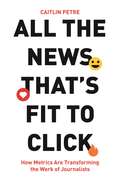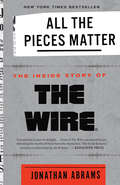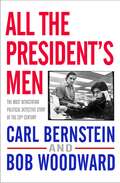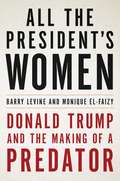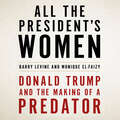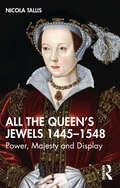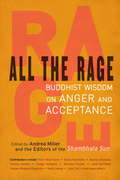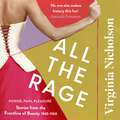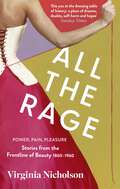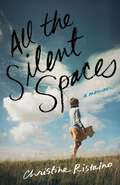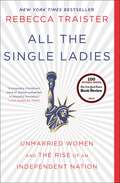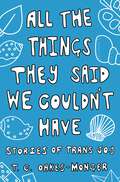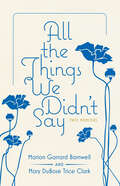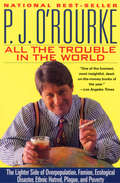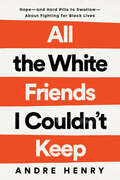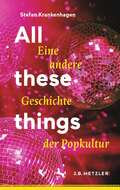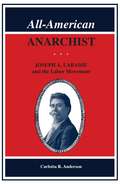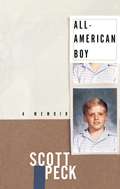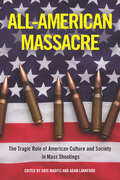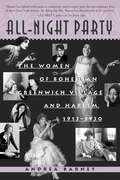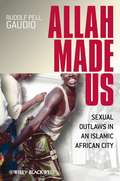- Table View
- List View
All the News That’s Fit to Click: How Metrics Are Transforming the Work of Journalists
by Caitlin PetreFrom the New York Times to Gawker, a behind-the-scenes look at how performance analytics are transforming journalism today—and how they might remake other professions tomorrowJournalists today are inundated with data about which stories attract the most clicks, likes, comments, and shares. These metrics influence what stories are written, how news is promoted, and even which journalists get hired and fired. Do metrics make journalists more accountable to the public? Or are these data tools the contemporary equivalent of a stopwatch wielded by a factory boss, worsening newsroom working conditions and journalism quality? In All the News That's Fit to Click, Caitlin Petre takes readers behind the scenes at the New York Times, Gawker, and the prominent news analytics company Chartbeat to explore how performance metrics are transforming the work of journalism.Petre describes how digital metrics are a powerful but insidious new form of managerial surveillance and discipline. Real-time analytics tools are designed to win the trust and loyalty of wary journalists by mimicking key features of addictive games, including immersive displays, instant feedback, and constantly updated “scores” and rankings. Many journalists get hooked on metrics—and pressure themselves to work ever harder to boost their numbers.Yet this is not a simple story of managerial domination. Contrary to the typical perception of metrics as inevitably disempowering, Petre shows how some journalists leverage metrics to their advantage, using them to advocate for their professional worth and autonomy.An eye-opening account of data-driven journalism, All the News That's Fit to Click is also an important preview of how the metrics revolution may transform other professions.
All the Pieces Matter: The Inside Story of The Wire®
by Jonathan Abrams<P>The definitive oral history of the iconic and beloved TV show The Wire, as told by the actors, writers, directors, and others involved in its creation. <P>Since its final episode aired in 2008, HBO's acclaimed crime drama The Wire has only become more popular and influential. The issues it tackled, from the failures of the drug war and criminal justice system to systemic bias in law enforcement and other social institutions, have become more urgent and central to the national conversation. <P>The show's actors, such as Idris Elba, Dominic West, and Michael B. Jordan, have gone on to become major stars. Its creators and writers, including David Simon and Richard Price, have developed dedicated cult followings of their own. Universities use the show to teach everything from film theory to criminal justice to sociology. Politicians and activists reference it when discussing policy. When critics compile lists of the Greatest TV Shows of All Time, The Wire routinely takes the top spot. It is arguably one of the great works of art America has produced in the 20th century. <P>But while there has been a great deal of critical analysis of the show and its themes, until now there has never been a definitive, behind-the-scenes take on how it came to be made. With unparalleled access to all the key actors and writers involved in its creation, Jonathan Abrams tells the astonishing, compelling, and complete account of The Wire, from its inception and creation through its end and powerful legacy. <P><b>A New York Times Bestseller</b>
All the Pope's Men: The Inside Story of How the Vatican Really Thinks
by John L. Allen Jr.A fascinating and enlightening look at the world's oldest and most mysterious institution, written by an American journalist with unparalleled knowledge about the Vatican's past and present. The sexual abuse scandals that shook American and British Catholicism in 2002 brought to light a long-standing cultural gap between the English-speaking Catholic world and the Vatican. In Rome, the crisis was often seen as an attack on the Church mounted by money-hungry lawyers, a hostile press, and liberal activists who used it as a way to turn attention on such concerns as celibacy, women's ordination, and lay empowerment. When the Vatican struck down the U. S. bishops' draft for handling allegations of sexual abuse, many saw it as an attempt to curb an independent American Catholic church. Yet, as time passed, it became clear that the Vatican's well-founded concerns about due process were shared by most liberal U. S. bishops and canon lawyers. ALL THE POPE'S MEN is a lucid, in-depth guide to the sometimes puzzling, often incomprehensible inner workings of the Vatican. It reveals how decisions are made, how papal bureaucrats think, and how careers in the Roman Curia are shaped. It debunks the myths that have fed the distrust and suspicions many English-speaking Catholics harbor about the way the Vatican conducts its business, explains who really wields the power, and offers entertaining profiles of the personalities, historical and present-day, who have wielded that power for good and for bad. A thoughtful analysis of the recent sexual abuse crisis sheds light on how the Vatican perceives the Church in the United States. Balanced, lively, and filled with Vatican history and lore, ALL THE POPE'S MEN provides the general reader with an authoritative picture of the highly charged relationship between the Vatican and the richest, most influential national Catholic church in the world today.
All the President's Men
by Bob Woodward Carl BernsteinIn the most devastating political detective story of the century, two Washington Post reporters, whose brilliant, Pulitzer Prize-winning investigation smashed the Watergate scandal wide open, tell the behind-the-scenes drama the way it really happened. <P><P> Beginning with the story of a simple burglary at Democratic headquarters and then continuing with headline after headline, Bernstein and Woodward kept the tale of conspiracy and the trail of dirty tricks coming -- delivering the stunning revelations and pieces in the Watergate puzzle that brought about Nixon's scandalous downfall. <P>Their explosive reports won a Pulitzer Prize for The Washington Post and toppled the President. This is the book that changed America.
All the President's Women: Donald Trump and the Making of a Predator
by Monique El-Faizy Barry LevineIs Trump merely a boor and a misogynist--or is he a predator?During his 2016 presidential run, the revelation of the Access Hollywood tape and subsequent allegations of sexual misconduct lodged against Donald Trump looked like they might doom his candidacy. Trump survived, and the first two years of the real estate scion's presidency were marked not by controversy over his behavior around women but by the Mueller investigation.So far, Trump has dodged the #MeToo bullet that has taken down so many once-powerful men. But despite the decades of tabloid fascination with his personal life, the story of Trump's relationship with women has never been fully told. Considering his bully pulpit in the White House, the reckoning is overdue.All the President's Women offers the most detailed account yet of Trump's history with women, dating back to his childhood and high school days through his rise in real estate, reality TV, and politics. This book will show that Trump's behavior goes far beyond occasional "locker-room talk" and unwanted advances.Barry Levine and Monique El-Faizy detail more than a dozen new allegations against Trump, including a disturbing attack on a woman at Mar-a-Lago, an incident at a private Manhattan sex club involving a teenage girl, as well as Trump's behavior at fashion shows and beauty pageants--events that gave the future president a hunting ground to harass young women.With groundbreaking interviews, behind-the-scenes reporting, and never-before-seen photos, veteran journalists Levine and El-Faizy tell the story of Trump from the point of view of the women in his orbit--wives, mistresses, playmates, and those whom the president has dated, kissed, groped, or lusted after.
All the President's Women: Donald Trump and the Making of a Predator
by Monique El-Faizy Barry LevineBased on groundbreaking original reporting, an extensive new look at Donald Trump's relationships with women, revealing new accusations of sexual misconduct, exploring the roots of his alleged predatory behavior, and illustrating how Trump's presidency has helped catalyze the #MeToo movement and revitalize women's activism.
All the President's Women: Donald Trump and the Making of a Predator
by Monique El-Faizy Barry LevineBased on groundbreaking original reporting, an extensive new look at Donald Trump's relationships with women, revealing new accusations of sexual misconduct, exploring the roots of his alleged predatory behavior, and illustrating how Trump's presidency has helped catalyze the #MeToo movement and revitalize women's activism.
All the Queen’s Jewels, 1445–1548: Power, Majesty and Display
by Nicola TallisFrom Margaret of Anjou to Katherine Parr, All the Queen’s Jewels examines the jewellery collections of the ten queen consorts of England between 1445–1548 and investigates the collections of jewels a queen had access to, as well as the varying contexts in which queens used and wore jewels. The jewellery worn by queens reflected both their gender and their status as the first lady of the realm. Jewels were more than decorative adornments; they were an explicit display of wealth, majesty and authority. They were often given to queens by those who wished to seek her favour or influence and were also associated with key moments in their lifecycle. These included courtship and marriage, successfully negotiating childbirth (and thus providing dynastic continuity), and their elevation to queenly status or coronation. This book explores the way that queens acquired jewels, whether via their predecessor, their own commission or through gift giving. It underscores that jewels were a vital tool that enabled queens to shape their identities as consort, and to fashion images of power that could be seen by their households, court and contemporaries. This book is perfect for anyone interested in medieval and Tudor history, queenship, jewellery and the history of material culture.
All the Rage
by Andrea MillerLeading psychologists and meditation teachers explain how mindfulness can help us work with our anger--and ultimately transform it into compassion. Anger. For all of us, it's a familiar feeling--jaw clenching, face flushing, hands shaking. We feel it for rational and irrational reasons, on a personal and on a global level. If we know how to handle our anger skillfully, it is an effective tool for helping us recognize that a situation needs to change and for providing the energy to create that change. Yet more often anger is destructive--and in its grip we hurt ourselves and those around us. In recent years scientists have discovered that mindfulness practice can reduce stress, improve mood, and enhance our sense of well-being. It also offers us a way of dealing with strong emotions, like anger. This anthology offers a Buddhist perspective on how we can better work with anger and ultimately transform it into compassion, with insight and practices from a variety of contributors, including Thich Nhat Hanh, Sharon Salzberg, Sylvia Boorstein, Carolyn Gimian, Tara Bennett-Goleman, Pat Enkyo O'Hara, Jules Shuzen Harris, Christina Feldman, Mark Epstein, Ezra Bayda, Judith Toy, Noah Levine, Judy Lief, Norman Fischer, Jack Kornfield, Stan Goldberg, Yongey Mingyur Rinpoche, Dzigar Kongtrül, and many others.
All the Rage: Power, Pain, Pleasure: Stories from the Frontline of Beauty 1860-1960
by Virginia NicholsonFrom the popular historian and author of Among the Bohemians and How Was It For You? comes a new offering, unbuttoning the multi-layered, hundred-year-history of women's lives through fashion and beauty from 1860 to 1960At the heart of this history is the female body.The century-span between the crinoline and the bikini witnessed more mutations in the ideal western woman's body shape than at any other period. In this richly detailed account, Virginia Nicholson, described as 'one of the great social historians of our time...' (Amanda Foreman) takes us to the Frontline of Beauty to reveal the power, the pain and the pleasure involved in adorning the female body.The PowerWho determines which shape is currently 'all the rage'? Looking at how custom, colour, class and sex fit into the picture, this book also charts how the advances made by feminism collided with the changing shape of desirability.The PainHere is Gladys, who had botched surgery on her nose; Dorothy, whose skin colour lost her an Oscar; Beccy who took slimming pills and died; and - unbelievably - the radioactive corset.The PleasureHere are the 'New Women' who discovered freedom by bobbing their hair; the boyish, athletic 'Health and Beauty' ladies in black knickers; and starlets in bohemian beachwear. Among the first to experience true women's liberation were the early adopters of trousers.Encompassing two world wars and a revolution in women's rights, All the Rage tells the story of western female beauty from 1860 to 1960, chronicling its codes, its contradictions, its lies, its highs - and its underlying power struggle.
All the Rage: Power, Pain, Pleasure: Stories from the Frontline of Beauty 1860-1960
by Virginia NicholsonFrom the popular historian and author of Among the Bohemians and How Was It For You? comes a new offering, unbuttoning the multi-layered, hundred-year-history of women's lives through fashion and beauty from 1860 to 1960At the heart of this history is the female body.The century-span between the crinoline and the bikini witnessed more mutations in the ideal western woman's body shape than at any other period. In this richly detailed account, Virginia Nicholson, described as 'one of the great social historians of our time...' (Amanda Foreman) takes us to the Frontline of Beauty to reveal the power, the pain and the pleasure involved in adorning the female body.The PowerWho determines which shape is currently 'all the rage'? Looking at how custom, colour, class and sex fit into the picture, this book also charts how the advances made by feminism collided with the changing shape of desirability.The PainHere is Gladys, who had botched surgery on her nose; Dorothy, whose skin colour lost her an Oscar; Beccy who took slimming pills and died; and - unbelievably - the radioactive corset.The PleasureHere are the 'New Women' who discovered freedom by bobbing their hair; the boyish, athletic 'Health and Beauty' ladies in black knickers; and starlets in bohemian beachwear. Among the first to experience true women's liberation were the early adopters of trousers.Encompassing two world wars and a revolution in women's rights, All the Rage tells the story of western female beauty from 1860 to 1960, chronicling its codes, its contradictions, its lies, its highs - and its underlying power struggle.
All the Rage: Power, Pain, Pleasure: Stories from the Frontline of Beauty 1860-1960
by Virginia NicholsonFrom the popular historian and author of Among the Bohemians and How Was It For You? comes a new offering, unbuttoning the multi-layered, hundred-year-history of women's lives through fashion and beauty from 1860 to 1960At the heart of this history is the female body.The century-span between the crinoline and the bikini witnessed more mutations in the ideal western woman's body shape than at any other period. In this richly detailed account, Virginia Nicholson, described as 'one of the great social historians of our time...' (Amanda Foreman) takes us to the Frontline of Beauty to reveal the power, the pain and the pleasure involved in adorning the female body.The PowerWho determines which shape is currently 'all the rage'? Looking at how custom, colour, class and sex fit into the picture, this book also charts how the advances made by feminism collided with the changing shape of desirability.The PainHere is Gladys, who had botched surgery on her nose; Dorothy, whose skin colour lost her an Oscar; Beccy who took slimming pills and died; and - unbelievably - the radioactive corset.The PleasureHere are the 'New Women' who discovered freedom by bobbing their hair; the boyish, athletic 'Health and Beauty' ladies in black knickers; and starlets in bohemian beachwear. Among the first to experience true women's liberation were the early adopters of trousers.Encompassing two world wars and a revolution in women's rights, All the Rage tells the story of western female beauty from 1860 to 1960, chronicling its codes, its contradictions, its lies, its highs - and its underlying power struggle.
All the Silent Spaces: A Memoir
by Christine RistainoIn September 2007, Christine Ristaino was attacked in a store parking lot while her three- and five-year-old children watched. In All the Silent Spaces, Ristaino shares what it felt like to be an ordinary person confronted with an extraordinary event—a woman trying to deal with acute trauma even as she went on with her everyday life, working at a university and parenting two children with her husband. She not only narrates how this event changed her but also tells how looking at the event through both the reactions of her community and her own sensibility allowed her to finally face two other violent episodes she had previously experienced. As new memories surfaced after the attack, it took everything in Ristaino&’s power to not let catastrophe unravel the precarious threads holding everything together. Moving between the greater issues associated with violence and the personal voyage of overcoming grief, All the Silent Spaces is about letting go of what you think you know in order to rebuild.
All the Single Ladies: Unmarried Women and the Rise of an Independent Nation
by Rebecca TraisterIn 2009, the award-winning journalist Rebecca Traister started All the Single Ladies—a book she thought would be a work of contemporary journalism—about the twenty-first century phenomenon of the American single woman. It was the year the proportion of American women who were married dropped below fifty percent; and the median age of first marriages, which had remained between twenty and twenty-two years old for nearly a century (1890–1980), had risen dramatically to twenty-seven.<P><P> But over the course of her vast research and more than a hundred interviews with academics and social scientists and prominent single women, Traister discovered a startling truth: the phenomenon of the single woman in America is not a new one. And historically, when women were given options beyond early heterosexual marriage, the results were massive social change—temperance, abolition, secondary education, and more.<P> Today, only twenty percent of Americans are wed by age twenty-nine, compared to nearly sixty percent in 1960. The Population Reference Bureau calls it a “dramatic reversal.” All the Single Ladies is a remarkable portrait of contemporary American life and how we got here, through the lens of the single American woman. Covering class, race, sexual orientation, and filled with vivid anecdotes from fascinating contemporary and historical figures, All the Single Ladies is destined to be a classic work of social history and journalism. Exhaustively researched, brilliantly balanced, and told with Traister’s signature wit and insight, this book should be shelved alongside Gail Collins’s When Everything Changed.
All the Single Ladies: Unmarried Women and the Rise of an Independent Nation
by Rebecca TraisterIn 2009, the award-winning journalist Rebecca Traister started All the Single Ladies—a book she thought would be a work of contemporary journalism—about the twenty-first century phenomenon of the American single woman. It was the year the proportion of American women who were married dropped below fifty percent; and the median age of first marriages, which had remained between twenty and twenty-two years old for nearly a century (1890–1980), had risen dramatically to twenty-seven.<P><P> But over the course of her vast research and more than a hundred interviews with academics and social scientists and prominent single women, Traister discovered a startling truth: the phenomenon of the single woman in America is not a new one. And historically, when women were given options beyond early heterosexual marriage, the results were massive social change—temperance, abolition, secondary education, and more.<P> Today, only twenty percent of Americans are wed by age twenty-nine, compared to nearly sixty percent in 1960. The Population Reference Bureau calls it a “dramatic reversal.” All the Single Ladies is a remarkable portrait of contemporary American life and how we got here, through the lens of the single American woman. Covering class, race, sexual orientation, and filled with vivid anecdotes from fascinating contemporary and historical figures, All the Single Ladies is destined to be a classic work of social history and journalism. Exhaustively researched, brilliantly balanced, and told with Traister’s signature wit and insight, this book should be shelved alongside Gail Collins’s When Everything Changed.
All the Things They Said We Couldn't Have: Stories of Trans Joy
by Tash Oakes-Monger'Transition has not been something linear for me, my joy has come in seasons.'Now, more than ever, trans people deserve to hear stories of joy and hope, where being trans doesn't have to be defined by fear and dysphoria, but can be experienced through courage, freedom, and the love and acceptance of their chosen families.Through a series of uplifting, generous and beautifully crafted vignettes, T. C. Oakes-Monger gently leads you through the cycle of the seasons - beginning in Autumn and the shedding of leaves and identity, moving through the darkness of Winter, its cold days, and the reality of daily life, into Spring, newness, and change, and ending with the joy of long Summer days and being out and proud - and invites you to find similar moments of joy in your life.Celebratory and empowering, these stories are a reminder of the power joy can bring.
All the Things We Didn't Say: Two Memoirs (Willie Morris Books in Memoir and Biography)
by Marion Garrard Barnwell Mary DuBose ClarkIn this poignant and introspective dual memoir, Marion Garrard Barnwell embarks on a deeply personal journey. Inspired by the memoir of her maternal grandmother, Mary DuBose Trice Clark, affectionately known as “Ganny,” the narratives, though separated by decades, are brought together to offer readers a unique and moving exploration of growing up in Mississippi and the intersections of family, motherhood, and self-discovery. Clark’s memoir, penned in 1956, offers readers a glimpse into the past, telling the story of her life in Mississippi with unwavering commitment to “just plain facts.” Her narrative traverses the landscapes of Okalona, Nettleton, Verona, and Tupelo, revealing their histories and the vibrant tapestry of her life while artfully sidestepping the complexities of her relationships and emotional vulnerabilities. Reflecting on an era when discussions of emotion and self-awareness were often shrouded in reticence, Clark’s story leaves a void in which Barnwell seeks to uncover the unspoken truths that shaped their family dynamics. Written at the age of seventy-seven, the same age as her grandmother when she wrote her memoir, Barnwell’s writing emerges as a response to the enigmatic silence within her grandmother’s narrative. It paints a vivid and expansive picture of her own life in the Mississippi Delta while also addressing profound themes of alcoholism, racism, shared family history, and the intricate dynamics between generations of women. As Barnwell weaves her own memoir into the fabric of this book, she takes readers on her emotional journey of self-discovery and truth-telling that leads to healing. All the Things We Didn’t Say: Two Memoirs is a testament to the power of storytelling and a captivating ode to the enduring human spirit and the timeless pursuit of understanding the intricate threads that connect us across generations.
All the Trouble in the World: The Lighter Side of Overpopulation, Famine, Ecological Disaster, Ethnic Hatred, Plague, and Poverty
by P. J. O'RourkeWith All the Trouble in the World, P. J. O'Rourke once again landed on best-seller lists around the country, confirming his reputation as the pre-eminent political humorist of our time. Attacking fashionable worries—all those terrible problems that are constantly on our minds and in the news, but about which most of us have no real clue—P. J. crisscrosses the globe in search of solutions to today's most vexing issues, including overpopulation, famine, plague, and multiculturalism, and in the process produces a hilarious and informative book which ensures that the concept of political correctness will never be the same again. "One of the funniest, most insightful, dead-on-the-money books of the year."—Los Angeles Times; "All the Trouble in the World is O'Rourke's best work since Parliament of Whores."—The Houston Post; "The dispatches are unfailingly funny....Mr. O'Rourke gets to the heart of the matter with a steady stream of wisecracks....Economists, political scientists and sociologists are inclined to approach the ills of society with regression analysis. P. J. O'Rourke just points and laughs. Not surprisingly, it is Mr. O'Rourke who gets it right."—The Washington Times; "Bottom line: Buy the book."—The Wall Street Journal.
All the White Friends I Couldn't Keep: Hope--and Hard Pills to Swallow--About Fighting for Black Lives
by Andre HenryA leading voice for social justice reveals how he stopped arguing with white people who deny the ongoing legacy of racism—and offers a proven path forward for Black people and people of color based on the history of nonviolent struggle.&“A moving personal journey that lends practical insight for expanding and strengthening the global antiracist movement.&”—Patrisse Khan-Cullors, co-founder of Black Lives Matter, bestselling author of When They Call You a TerroristWhen the rallying cry &“Black Lives Matter&” was heard across the world in 2013, Andre Henry was one of the millions for whom the movement caused a political awakening and a rupture in some of his closest relationships with white people. As he began using his artistic gifts to share his experiences and perspective, Henry was aggrieved to discover that many white Americans—people he called friends and family—were more interested in debating whether racism existed or whether Henry was being polite enough in the way he used his voice.In this personal and thought-provoking book, Henry explores how the historical divides between Black people and non-Black people are expressed through our most mundane interactions, and why this struggle won&’t be resolved through civil discourse, diversity hires, interracial relationships, or education. What we need is a revolution, one that moves beyond symbolic progress to disrupt systems of racial violence and inequality in tangible, creative ways.Sharing stories from his own path to activism—from studying at seminary to becoming a student of nonviolent social change, from working as a praise leader to singing about social justice—and connecting those experiences to lessons from successful nonviolent struggles in America and around the world, Andre Henry calls on Black people and people of color to divest from whiteness and its false promises, trust what their lived experiences tell them, and practice hope as a discipline as they work for lasting change.
All these things: Eine andere Geschichte der Popkultur
by Stefan KrankenhagenPopkultur dreht sich immer schon um die ganz besonderen und die ganz normalen Dinge: von Winnetous Silberbüchse über Kaugummis, Diskokugeln und Nylonstrümpfen bis zu Selfiesticks und Michael Jacksons weißem Handschuh. Sie werden alltäglich genutzt und abgöttisch verehrt, sind überall verfügbar und unerreichbar, sind spektakuläre Unikate und billige Massenprodukte. – All these things erzählt die Geschichte der Popkultur vom Ende des 19. Jahrhunderts bis zur Gegenwart anhand von 14 ausgewählten Dingen. Sie alle haben ihre eigene Geschichte und stehen für die kulturellen, technischen und ökonomischen Veränderungen der Zeit – vor allem aber für 150 Jahre Unterhaltungskultur.
All-American Anarchist: Joseph A. Labadie and the Labor Movement (Great Lakes Books Series)
by Carlotta R. AndersonAll-American Anarchist chronicles the life and work of Joseph A. Labadie (1850-1933), Detroit's prominent labor organizer and one of early labor's most influential activists. A dynamic participant in the major social reform movements of the Gilded Age, Labadie was a central figure in the pervasive struggle for a new social order as the American Midwest underwent rapid industrialization at the end of the nineteenth century. This engaging biography follows Labadie's colorful career from a childhood among a Pottawatomie tribe in the Michigan woods through his local and national involvement in a maze of late nineteenth-century labor and reform activities, including participation in the Socialist Labor party, Knights of Labor, Greenback movement, trades councils, typographical union, eight-hour-day campaigns, and the rise of the American Federation of Labor. Although he received almost no formal education, Labadie was a critical thinker and writer, contributing a column titled "Cranky Notions" to Benjamin Tucker's Liberty, the most important journal of American anarchism. He interacted with such influential rebels and reformers as Eugene V. Debs, Emma Goldman, Henry George, Samuel Gompers, and Terence V. Powderly, and was also a poet of both protest and sentiment, composing more than five hundred poems between 1900 and 1920. Affectionately known as Detroit's "Gentle Anarchist," Labadie's flamboyant and amiable personality counteracted his caustic writings, making him one of the city's most popular figures throughout his long life despite his dissident ideals. His individualistic anarchist philosophy was also balanced by his conventional personal life - he was married to a devout Catholic and even worked for the city's water commission to make ends meet. In writing this biography of her grandfather, Carlotta R. Anderson consulted the renowned Labadie Collection at the University of Michigan, a unique collection of protest literature which extensively documents pivotal times in American labor history and radical history. She also had available a large collection of family scrapbooks, letters, photographs, and Labadie's personal account book. Including passages from Labadie's vast writings, poems, and letters, All-American Anarchist traces America's recurring anti-anarchist and anti-radical frenzy and repression, from the 1886 Haymarket bombing backlash to the Red Scares of the twentieth century.
All-American Boy
by Scott Peck"A survivor's tale that in its universal appeal brings to mind the most compelling aspects of "Gal" and "Shot in the Heart." Through the course of these scathing, inspiring, instructive pages, Scott Peck, writer and human being, grows into one hell of a terrific man.".--Michael Dorris.
All-American Massacre: The Tragic Role of American Culture and Society in Mass Shootings
by Eric Madfis and Adam LankfordWhat elements of contemporary American life contribute to the United States having the greatest number and highest share of public mass shootings around the globe? The editors and contributors to All-American Massacre seek to answer this question by exploring how masculinity, racism, politics, media, fame, education, gun culture, and mental health influence the causes of mass shootings in the United States. With a specific focus on exploring how American culture, institutions, and social structures influence the circumstances, frequency, and severity of mass shootings in the United States, All-American Massacre advances emerging theoretical perspectives and forges fresh approaches, new research questions, and innovative data and conclusions. Bringing together pioneering scholars, this groundbreaking compilation of research and analysis identifies the social roots of this insidious threat and prompts new reflections on how we can stop the seemingly endless cycle of horror and death.All-American Massacre helps clarify the unique nature and salience of mass shootings in American life. Contributors: Melanie Brazzell, Tristan Bridges, Ryan Broll, F. Chris Curran, Sarah E. Daly, Salvatore D’Angelo, James Densley, Tom Diaz, Scott Duxbury, Benjamin W. Fisher, Betsy Friauf, Emma E. Fridel, Celene Fuller, Daniel Gascón, Patrick J. Gauding, Brooke Miller Gialopsos, Simon Gottschalk, Donald P. Haider-Markel, Stephanie Howells, Cheryl Lero Jonson, Mark R. Joslyn, Jessie Klein, Aaron Kupchik, Alison J. Marganski, Melissa M. Moon, Kristen J. Neville, Jaimee Nix, Daniel Okamura, Patrick F. Parnaby, Jillian Peterson, Michael Phillips, Paul Reeping, Jason R. Silva, William A. Stadler, Lindsay Steenberg, Tara Leigh Tober, Jillian J. Turanovic, Abigail Vegter, Stanislav Vysotsky, Lacey N. Wallace and the editors
All-Night Party: The Women of Bohemian Greenwich Village and Harlem, 1913-1930
by Andrea BarnetThey were smart. Sassy. Daring. Exotic. Eclectic. Sexy. And influential. One could call them the first divas--and they ran absolutely wild. They were poets, actresses, singers, artists, journalists, publishers, baronesses, and benefactresses. They were thinkers and they were drinkers. They eschewed the social conventions expected of them--to be wives and mothers--and decided to live on their own terms. In the process, they became the voices of a new, fierce feminine spirit.There's Mina Loy, a modernist poet and much-photographed beauty who traveled in pivotal international art circles; blues divas Bessie Smith and Ethel Waters; Edna St. Vincent Millay, the lyric poet who, with her earthy charm and passion, embodied the '20s ideal of sexual daring; the avant-garde publishers Margaret Anderson and Jane Heap; and the wealthy hostesses of the salons, A'Lelia Walker and Mabel Dodge. Among the supporting cast are Emma Goldman, Isadora Duncan, Ma Rainey, Margaret Sanger, and Gertrude Stein.Andrea Barnet's fascinating accounts of the emotional and artistic lives of these women--together with rare black-and-white photographs, taken by photographers such as Berenice Abbott and Man Ray--capture the women in all their glory. This is a history of the early feminists who didn't set out to be feminists, a celebration of the rebellious women who paved the way for future generations.
Allah Made Us: Sexual Outlaws in an Islamic African City (New Directions in Ethnography #5)
by Rudolf Pell GaudioA rich and engrossing account of 'sexual outlaws' in the Hausa-speaking region of northern Nigeria, where Islamic law requires strict separation of the sexes and different rules of behavior for women and men in virtually every facet of life. The first ethnographic study of sexual minorities in Africa, and one of very few works on sexual minorities in the Islamic world Engagingly written, combining innovative, ethnographic narrative with analyses of sociolinguistic transcripts, historical texts, and popular media, including video, film, newspapers, and song-poetry Analyzes the social experiences and expressive culture of ‘yan daudu (feminine men in Nigerian Hausaland) in relation to local, national, and global debates over gender and sexuality at the turn of the twenty-first century Winner of the 2009 Ruth Benedict Prize in the category of "Outstanding Monograph"
